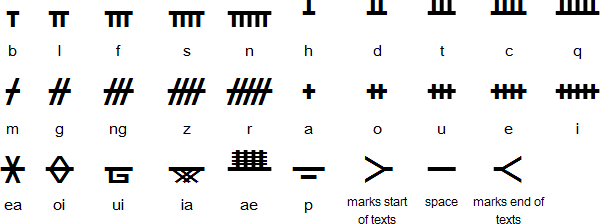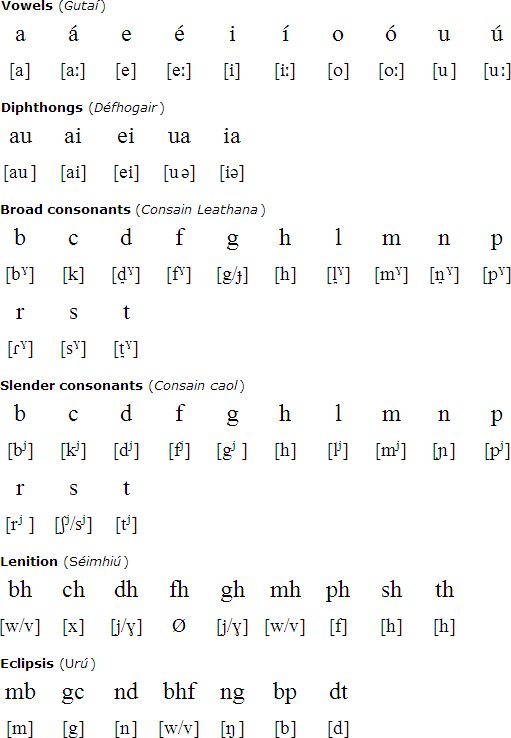Irish is a Celtic language spoken in mainly Ireland (Éire). There are also Irish speakers in the UK (Ríocht Aontaithe), the USA (Stáit Aontaithe Mheiriceá), Canada (Ceanada) and Australia (an Astráil).
According to the 2016 census, 1.76 million people in Ireland claim to speak Irish; 73,803 speak it daily; 111,473 speak it weekly; 586,535 speak less frequently, and the rest rarely speak it. The main concentrations of Irish speakers are in the Gaeltachtaí, which are scattered mainly along the west coast of Ireland and have a total population of 96,090. On average 66% of Gaeltacht residents can speak Irish.
In 2011 the UK census found that 184,898 people in Northern Ireland (10.65% of the population) have some knowledge of Irish, and that 104,943 of them can speak the language to some degree. Irish is the main home language for about 4,130 people in Northern Ireland [source]. According to another source, there are about 9,000 fluent speakers of Irish in Britain. Whether this includes Northern Ireland is not clear.
According to the 2005 US census, about 18,815 people spoke Irish at home in the USA, especially in the northeastern states. There are Irish language courses at some universities and colleges in the USA and Canada [source].
In 2011 1,895 people in Australia said that they use Irish as their home language, and it is possible to study Modern and Old Irish at the University of Sydney [source].
Irish is known as Irish, Gaelic or Irish Gaelic in English. The official standard name in Irish is Gaeilge /ˈɡeːlʲɟə/. Before the 1948 spelling reform, this was spelled Gaedhilge. In Middle Irish the name was spelled Gaoidhealg, in Classical Irish it was Gaoidhealg [ˈɡeːʝəlˠɡ], and it was Goídelc in Old Irish.
In Ulster and northern Connacht, Irish is known as Gaedhilic/Gaeilic/Gaeilig [ˈɡeːlʲɪc] or Gaedhlag [ˈɡeːl̪ˠəɡ], In Munster it is known as Gaedhealaing/Gaoluinn/Gaelainn [ˈɡeːl̪ˠɪŋʲ/ˈɡeːl̪ˠɪnʲ].
When a distinction needs to be made between Irish (Gaeilge), Scottish Gaelic (Gàidhlig) and/or Manx (Gaelg), Irish is referred to as Gaeilge na hÉireann (Irish Gaelic).
Irish is a member of the Goidelic branch of Celtic languages, also known as Q-Celtic. It is closely related to Manx (Gaelg/Gailck) and Scottish Gaelic (Gàidhlig), the other Goidelic languages. There is some degree of mutual intelligibility between them, particular between the Scottish Gaelic of Islay and Argyll, Ulster Irish, and Manx. The grammar and vocabulary of these languages are quite similar, but the spelling and pronunciation are different, especially Manx spelling.
Irish is distantly related to Welsh (Cymraeg), Cornish (Kernewek) and Breton (Brezhoneg), which form the Brythonic branch of the Celtic languages, also known as P-Celtic. The Celtic languages all have a similar grammatical structure, but have relatively little vocabulary in common.
There are three main dialects of Irish: Munster (An Mhumhain), Connacht (Connachta) and Ulster (Ulaidh). The Munster dialect is spoken mainly in Kerry (Ciarraí) and Muskerry (Múscraí) in the western part of County Cork (Contae Chorcaí). The Connacht dialect is spoken mainly in Connemara (Conamara), the Aran Islands (Oileáin Árann) and Tourmakeady (Tuar Mhic Éadaigh) in County Mayo (Maigh Eo). The main area where the Ulster dialect is spoken is the Rosses (na Rosa). The dialect of Gweedore (Gaoth Dobhair) is essentially the same as the Ulster dialect.
During the 1950s and 1960s a standardised form of Irish, known the An Caighdeán Oifigiúil (The Official Standard) was developed. It combines elements from the three major dialects and its pronunciation is based on the Connacht dialect. This is the form of the language taught in most schools.
Between the 17th and early 20th centuries, the Irish language was gradually replaced by English in most parts of Ireland. Famine and migration in the 19th and 20th centuries led to its further decline. However when the Republic of Ireland came into being in 1922, Irish was adopted as an official language, along with English, and the government and civil service become, in theory at least, officially bilingual. Irish terms were also adopted for the titles of public figures and organisations - Garda (Police), Taoiseach (Prime Minister), Dáil (Parliament).
Recently the Irish language has experienced a revival with the foundation of new publications, a radio service, a television station and the growth of Irish-medium education. Irish is also increasingly being used on independent radio stations in Ireland.
Irish first began to appear in writing in Ogham inscriptions between the 4th and 6th centuries AD. When St Patrick introduced Christianity to Ireland in the 5th century, Irish writers began to write in Latin, and at the same time Irish literature written in the Latin alphabet began to appear. The Viking invasions of the 9th and 10th centuries led to the destruction of many early manuscripts, so most surviving manuscripts were written after that time.
The Ogham alphabet was used to write Archaic Irish, Old Welsh and Latin and Ogham inscriptions have been found in various parts of Ireland and the British Isles.

The Gaelic Script originated in medieval manuscripts as a variant of the Latin alphabet. It was used for printing Irish until quite recently and is still used on road signs and public notices throughout Ireland.

More information about the Gaelic Script
Today Irish is usually written with a version of the Latin alphabet similar to the one used for Scottish Gaelic, though a spelling reform in 1957 eliminated some of the silent letters which are still used in Scottish Gaelic.
| A a | B b | C c | D d | E e | F f | G g | H h | I i |
|---|---|---|---|---|---|---|---|---|
| á | bé | cé | dé | é | eif | gé | héis | í |
| L l | M m | N n | O o | P p | R r | S s | T t | U u |
| eil | eim | ein | ó | pé | ear | eas | té | ú |
Hear the Irish alphabet:
The letters j (jé), k (ká), q (cú), v (vé), w (wae), x (ex), y (yé) and z (zae) do not occur in native Irish words, but do appear in some English loanwords, for example jab (job) and veain (van).
You can hear the names of the letters at:
http://www.smo.uhi.ac.uk/gaeilge/gramadach/aibitir/

Download an alphabet chart for Irish (Excel)
Saolaítear na daoine uile saor agus comhionann ina ndínit agus ina gcearta. Tá bua an réasúin agus an choinsiasa acu agus dlíd iad féin d'iompar de mheon bráithreachais i leith a chéile.
A recording of this text by Seán Ó Súilleabháin (from county Kerry)
All human beings are born free and equal in dignity and rights. They
are endowed with reason and conscience and should act towards one another
in a spirit of brotherhood.
(Article 1 of the Universal Declaration of Human Rights)
Irish language | Gaelic script | Ogham alphabet | Phrases | Numbers: Modern Irish, Middle Irish, Old Irish | Colours | Family words | Terms of endearment | Time | Dates | Weather | Proverbs | Comparison of Celtic languages | Celtic cognates | Celtiadur | Tower of Babel | Tongue twisters | Songs | Learning materials | Books about Ogham | My podcast about Irish | Links
Information about the Irish language
http://en.wikipedia.org/wiki/Irish_language
https://en.wikipedia.org/wiki/Irish_language_in_Northern_Ireland
https://en.wikipedia.org/wiki/Irish_language_outside_Ireland
http://www.udaras.ie/en/an-ghaeilge-an-ghaeltacht/stair-na-gaeilge/
http://aboutworldlanguages.com/irish-gaelic
http://www.bbc.co.uk/voices/multilingual/irish_history.shtml
http://www.endangeredlanguages.com/lang/3437
Online Irish lessons
http://www.rte.ie/easyirish/
http://www.bbc.co.uk/northernireland/irish/blas/learners/
http://www.gaeltalk.net
http://homepage.eircom.net/~eofeasa/
http://www.irishpage.com/irishpeople/
http://www.daltai.com/
http://www.eirefirst.com/lessonintro.html
http://www.rte.ie/tv/turasteanga/
http://www.bitesizeirishgaelic.com
More Irish language-related links
Irish learning software
http://www.linguashop.com/irish-language
Breton, Celtiberian, Cornish, Cumbric, Gaulish, Irish, Lepontic, Lusitanian, Manx, Scottish Gaelic, Welsh
Languages written with the Latin alphabet
Page last modified: 24.03.24
[top]
You can support this site by Buying Me A Coffee, and if you like what you see on this page, you can use the buttons below to share it with people you know.

If you like this site and find it useful, you can support it by making a donation via PayPal or Patreon, or by contributing in other ways. Omniglot is how I make my living.
Note: all links on this site to Amazon.com, Amazon.co.uk
and Amazon.fr
are affiliate links. This means I earn a commission if you click on any of them and buy something. So by clicking on these links you can help to support this site.
[top]